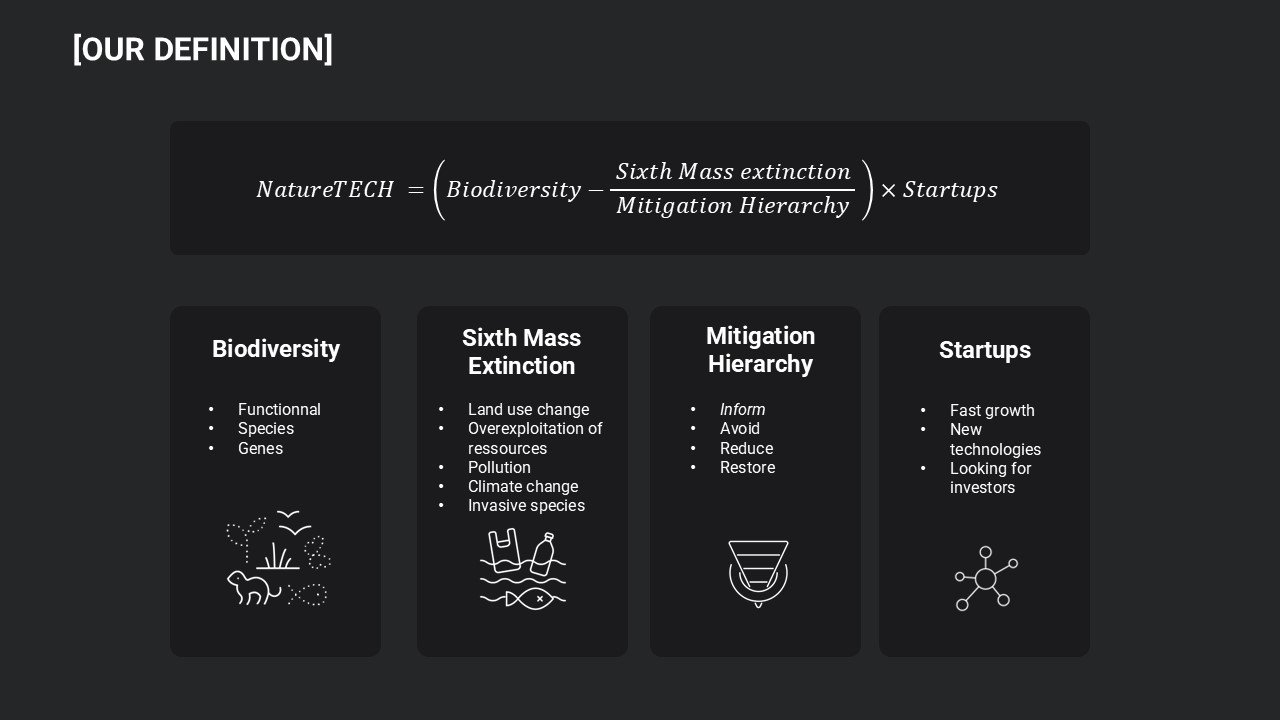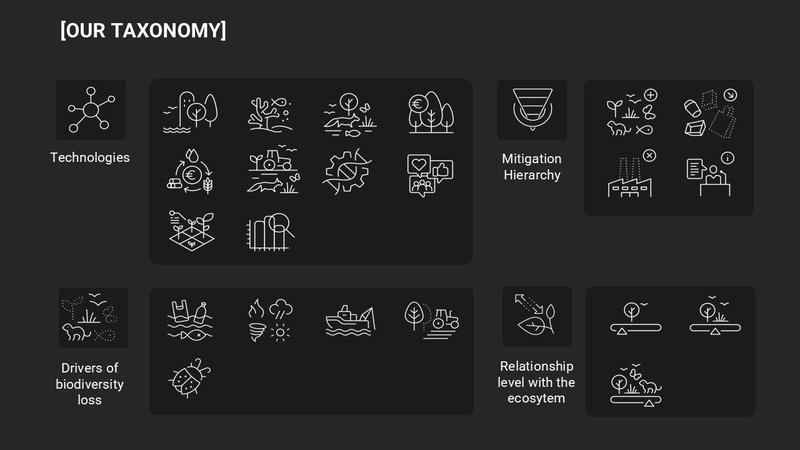[Method] What we define as NatureTECH
Nov. 7, 2024

Mainstreaming nature and biodiversity solutions for the corporate and financial world
Definitions
Biodiversity - According to the Intergovernmental Science-Policy Platform on Biodiversity and Ecosystem Services (IPBES), biodiversity refers to the variety of all forms of life on Earth and the interactions within and between each of these, including three levels among them ecological diversity (ecosystems); specific diversity (species) ; genetic diversity (genes). Biodiversity is fundamental for ecosystem health and human well-being and underpins essential ecosystem services businesses rely on, such as food, clean water, air quality, climate regulation, and the cultural and spiritual benefits humans derive from nature.
Sixth Mass extinction - also known as the Holocene extinction or Anthropocene extinction, it refers to the rapid loss of animals, plants and biodiversity on Earth, driven primarily by human activities (Barnosky et al., 2011). Currently, the species extinction rate is estimated between 1,000 and 10,000 times higher than natural extinction rates—the rate of species extinctions that would occur if we humans were not around (WWF, 2024). It is a clear indication of our ecosystems' health overall decline and their ability to support our current economic activities for much longer.

Key drivers as described by IPBES include:
- Land-use change (e.g., deforestation, urbanization, agriculture)
- Overexploitation of ressources (e.g., overfishing, poaching)
- Pollution (e.g., plastic waste, chemicals, air and water contamination)
- Climate change, which alters ecosystems and threatens species unable to adapt
- Invasive species, introduced by humans, which outcompete native species
Mitigation Hierarchy – How to bend the curve of biodiversity loss? By a rapid and systemic mitigation of our negative impacts thanks to a structured and stepwise strategy toward achieving no net loss of biodiversity (2030). Such a hierarchy seeks to deeply transform our organisations:
- Avoid: the first and most important step, which seeks to avoid impacts on biodiversity by carefully planning and designing projects and products to prevent or minimize damage. Sobriety is the key – just leave it alone.
- Reduce: if impacts cannot be entirely avoided, this step involves reducing the extent, intensity, and duration of biodiversity impacts as much as possible (replace with a more sustainable material, reduce the duration or the surface [DM3] of a project, etc.). Sometimes, less is more.
- Restore: 30% of of degraded terrestrial, inland water, coastal and marine ecosystems need to be restored by 2030 to ensure a safely operating space for humanity within planetary limits (GBF, 2022). This can be made through two different channels of financing: regulatory (offset) or voluntary contribution (certificates). A way to repair something that has been broken.
Disclaimer - we don’t need just TECH, but we definitely need more TECH
Overall impact of technical solutions - The aim of this platform is not to assess which start-ups are needed to tackle the biodiversity crisis, but to identify a trend and a general opportunity to contribute to the Kunming-Montreal targets.
No analysis has been conducted regarding the relevance of the solutions in reducing the biodiversity crisis. As it stands, we rely on what the start-ups themselves state and leave it up to the reader to form an opinion.
Start-ups can’t replace public policies and structural changes – by analysing and promoting the NatureTECH ecosystem, we could be indirectly underlying the idea that start-ups can break the tie. Such an opinion could diminish the severity of the current crisis and the magnitude of the structural changes to be implemented. For instance, a start-up specialising in cosmetics can develop organic, pesticide-free products using less resource-intensive materials . The product seems to fit with an overall reduction of the cosmetic industry global footprint – yet there is no guarantee that this product will not be purchased 10 or 100 times more, cancelling any reduction of the associated pressure as part of a rebound effect.
Adding product-oriented approaches will not solve a problem for which solutions are not always scalable and venture-capital compatible. For instance, ecosystem restoration projects often require adaptability and flexibility better suited to project finance.
Let’s bring TECH to the table - We think it is time to break down walls and mix the in-depth expertise of the biodiversity community with the agility of start-ups and early-stage investors.
Investing in NatureTECH start-ups seems to be a good proxy to mainstream biodiversity and nature in the business world. Private equity can bring innovative approaches to environmental issues and challenges, particularly by helping to scale and industrialise solutions. It can also provide its technological expertise, for instance by making it easier for companies to report using AI solutions or by enabling more accurate and more numerous data to be collected on the ground. Existing solutions need dedicated channels within venture capital. Their inspiring stories can be a strong catalyst to the global business world and help gather larger crowds (and money) for the conservation of our natural world.
To this day, our analyses are an ongoing process, we deliberately did not assess the transformative potential and scientific existing (or not existing) consensus about any of the developed solutions. Contact us for further details about this incoming investigation.
Back to the articles